We hope that you enjoy this article on 7 Lesser Known African Mammals. This part of the world often captivates the imagination and awe of many, and deservedly so. The region teems with natural beauty, in a multitude of forms. In this article, however, we are restricting ourselves to its population of mammals. More specifically, as the title implies, those that the majority of people around the world may not know about. Naturally, this list only covers a tiny handful of those species in the region. If you enjoy learning about these, we invite you to explore more of our articles.
Black Footed Cat
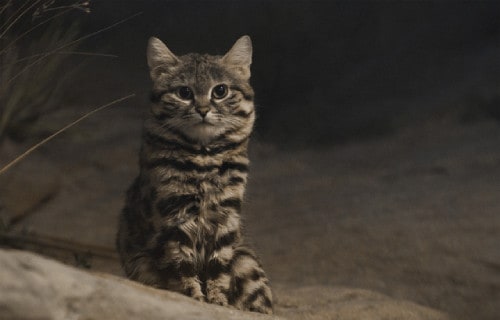
CCL: http://bit.ly/2xQPH8p
Black Footed Cat Facts
- Leading off this list of 7 Lesser Known African Mammals is the first of two felines contained herein, the Black Footed Cat.
- Most notably, this wonderful animal remains one of the smallest known species of a wild feline on earth. Can you believe that this adorable little creature actually ranks as a wildcat?
- The remarkable car also has a highly solitary nature and almost completely nocturnal behavior. Further, this animal rarely emerges from its resting places before sunset, at which time it hunts its prey.
- Due to these factors, men rarely see it, thus we still know little about them. Its numbers appear to be few, however, so the IUCN presently lists the Black Footed Cat as Vulnerable.
- Uniquely, it also seems to be a relatively poor climber for a feline and avoids climbing when possible.
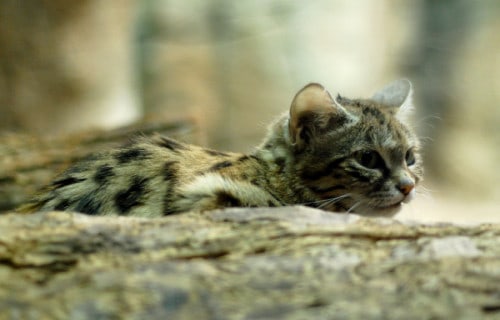
CCL: http://bit.ly/2xQPH8p
Black Footed Cat Physical Description
Firstly, the common name Black Footed Cat actually remains somewhat deceptive. That’s because, in spite of the descriptive name, only the bottom of the feet appear fully black in color. Yet, the name seems to fit.
The species also displays a moderate degree of sexual dimorphism. The adult male Black Footed Cat averages roughly 4.2 lb (1.9 kg) in weight. Meanwhile, the female usually only reaches 2.9 lb (1.3 kg) in weight.
Additionally, the species remains smaller than many domesticated felines. Head to body length averages roughly 17 in (43 cm) among males. However, the female of the species grows slightly shorter in length.
Its ears also have a rounded shape, and the eyes appear comparatively large. Finally, the fur varies in color from tawny to cinnamon. But, patterns of dark spots forming rings appear on various body locations.
- Kingdom: Animalia
- Phylum: Chordata
- Class: Mammalia
- Order: Carnivora
- Family: Felidae
- Genus: Felis
- Species: F. nigripes
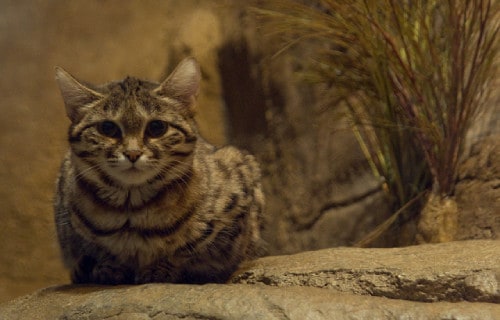
CCL: http://bit.ly/2zDnGC2
Black Footed Cat Distribution, Habitat, and Ecology
First of all, the amazing Black Footed Cat evolved as native to select portions of southern Africa. Due to this fact, the animal only lives in Namibia, South Africa, and Zimbabwe. It remains unknown if it once had a wider range.
In addition, it inhabits either grassland, savanna, and Karoo semi-desert. The fascinating animal seems to prefer shrub and tree cover. It also may be found at altitudes of as much as 6,600 ft (2,000 m).
During the heat of the day, he resourceful feline takes measures to escape the heat of its surroundings. Therefore, individuals will most typically inhabit small burrows or abandoned termite mounds.
Furthermore, the small felines remain extremely active and highly proficient hunters. Because of its skill, most individuals typically catch a dozen or more small prey each night.
Finally, individuals generally feed on such varied prey as small birds and rodents, hunting these by preference. Yet many will not hesitate to consume insects and spiders opportunistically.
Oribi
Oribi Facts
- Our next choice among these 7 Lesser Known African Mammals is the amazing animal with the short common name of Oribi.
- This beautiful small variety of antelope goes by one relatively short common name. For the moment, the remarkable mammal has no alternate common term. Its scientific name, meanwhile, is the the short yet hard to pronounce term of the Ourebia ourebi.
- It owes that name to the individual who accomplished the first formal recognition of it as a distinct species. This action occurred in 1783. It took place as a result of the work of the renowned German zoologist Eberhard August Wilhelm von Zimmermann.
- Presently, this marvel of Nature represents the only member of its genus. A number of recognized subspecies do exist, however. At present, researchers acknowledge a total of eight of these subspecies. More of these could potentially be recognized.
- As a species, this animal currently stands on a cusp concerning its status. That’s partly because, for now, the IUCN lists it as a Species of Least Concern, on its Red List. It holds that status due to the fact that it still has a relatively sizeable population base.
- That base, however, appears to be declining rapidly. At present, this unfortunate trend derives from local human actions. More specifically, agricultural expansion by man has adversely affected it. It further now faces competition from livestock for food.
- These now pose a threat to the Oribi on a local scale. The reduction on habitat from the expansion of agricultural efforts does so especially. These facts, however, only serve to potentially make it even more vulnerable to the effects of climate change.
Oribi Physical Description
The magnificent Oribi enthralls those who see the creature with its distinctive appearance. It also bears noting for another reason. That has to do with its sheer size That holds true due to the fact that this wonder of evolution represents a small variety of antelope.
Like many types of mammals, it also displays a moderate degree of the physiological trait of sexual dimorphism. In its specific case, though, this trait manifests itself in two ways. The first, no surprisingly, is in terms of simple physical size, like most of its relatives.
More precisely, females of the species generally attain a slightly greater height and weight. Overall, however, the animal achieves a shoulder height of 20 – 26 in (50 – 67 cm). An average head-and-body length, meanwhile, measures roughly 36 – 43 in (92 – 110 cm).
Its body weight represents the greatest variable, though. Most specimens reach a weight of between 26 – 49 lb (12 – 22 kg). This range, however, appears to have no relation to the gender of the individual. Individuals also possess a relatively short, thin tail.
The other form of gender based physical variation the Oribi displays occurs on the head. That’s because the males develop a pair of horns, while the females do not. These develop as thin, straight, and short. These range in length from 3.1 – 7.1 in (8 – 18 cm).
The two genders remain otherwise similar in appearance. Both develop a thin body, long limbs and neck. Both also display a slightly raised back. Most of the coat displays a glossy dark yellow to light brown color. The throat, chin, rump, and belly are white.
- Kingdom: Animalia
- Phylum: Chordata
- Class: Mammalia
- Order: Artiodactyla
- Family: Bovidae
- Genus: Ourebia
- Species: O. ourebi
Oribi Distribution, Habitat, and Ecology
The awesome Oribi possesses a moderately broad range. That’s because the somewhat small mammal evolved as endemic to a specific portion of the continent of Africa. Unfortunately, though, that range of habitation also qualifies as highly sporadic in nature.
More precisely, it appears in the western, southern, and eastern sections of the continent. Within that region, its territory extends from Nigeria and Senegal in the west. From there it reaches through Eritrea in the east, then south to Angola and the Eastern Cape.
Luckily, however, within that range it evolved as highly adaptable in terms of habitat. Due to that, the animal thrives in a multitude of habitats. These include regions of tropical grasslands, floodplains. It seems most prevalent, though, in areas of savannah.
It further lives at a wide range of altitudes. Populations appear from low altitude ranges up to as high as 6,600 ft (2,00 m) above sea level. Its most important criteria for where it dwells seems to be the presence of cover sufficient to hide it from its predators.
The marvelous Oribi further evolved as diurnal in nature, meaning its mainly active during the day. Individuals do occasionally display activity at night as well, though. The animal also prefers to remain under cover during periods of locally heavy rain.
Like most of its relatives, the delicate beauty evolved as a herbivore. In its case, it feeds primarily as a grazer. Individuals principally feed on various locally available fresh grasses. About 10% of its diet, however, consists of mushrooms and various flowers.
Pangolin
Pangolin Facts
- The third of our 7 Lesser Known African Mammals is the extraordinarily unique Pangolin.
- Most notably, the incredible animal remains the only known mammal to have evolved protective scales. Due to the presence of these, people sometimes call it the scaly anteater.
- The animal also constitutes the only surviving member of a family. In addition, only four known species of this unique creature exist.
- Sadly, this impressive species now lists as Critically Endangered with the IUCN. This occurs partly for a very sad reason. That’s because the Pangolin remains the most heavily hunted mammal in the world.
- However, the amazing creature now enjoys protection under the law. But, illegal hunting continues. It still gets hunted both as a source of bushmeat and for its scales, which get used in making clothing.
- Finally, the animal also gets hunted for use in making traditional medicines.
Pangolin Physical Description
Due to its rather distinctive appearance, the Pangolin remains easily recognizable. In recent times, it has even become something of a media sensation. This occurs due to the coincidental evolution of a unique visage.
Additionally, the scales covering its body grow large in relation to body size. Furthermore, these are composed of keratin. Each scale also possesses a sharp edge, further increasing the protection they provide.
As a result of their nature, these scales serve to protect the Pangolin from most of its would-be predators. Further, the animal curls into a tight ball when threatened, presenting these to the attacker.
The various species range in length from 12-39 in (30-100 cm). Average weight is about 4.4 lb (2 kg). Gender-based physical differences are also present, with males averaging 50% larger than females.
The legs grow short, giving it a low-slung form. It also possesses a thin tongue which the animal can extend as much as 16 in (40 cm).
The claws are relatively long and quite powerful. In addition to its armor, it also has a second defense mechanism. When threatened, it can release a noxious-smelling chemical from glands near the base of its tail.
- Kingdom: Animalia
- Phylum: Chordata
- Class: Mammalia
- Order: Pholidota
- Family: Manidae
Pangolin Distribution, Habitat, and Ecology
First of all, the amazing Pangolin evolved as endemic to a specific habaitat range. This mainly consists of certain parts of both Asia and Africa. It also inhabits either grasslands or forests within that range.
The majority of the different species live as nocturnal, yet one appears active by day. It typically makes its homes in either hollow trees or deep burrows. These burrows may be as much as 11 ft (3.5 m) deep.
Its diet consists mainly of termites and ants, which it locates with its keen sense of smell. These it extracts with its specially adapted tongues.
This extraordinary creature typically walks on all four legs, yet remains capable of walking on its rear legs only for a short time. It also seems to be an excellent swimmer.
This animal lives a primarily solitary life, usually meeting only to mate. A typical litter contains 1-3 offspring.
Elephant Shrew
Elephant Shrew Facts
- The fourth choice for this compendium of 7 Lesser Known African Mammals is the incredible Elephant Shrew.
- Not surprisingly, this selection tops many lists of remarkable small mammals. This status exists because it has several attributes normally associated with other animals.
- However, several species of this amazing small animal exist. Furthermore, all of them have prehensile snouts, the same as an elephant. This, therefore, serves as the source of the common name.
- Further, the IUCN currently lists two of those species as either Vulnerable or Endangered. But, the other forms of the creature may soon hold the same status. This holds true due to declining populations.
- This animal can move extremely rapidly and agilely for a small mammal. In fact, it ranks as one of the fastest of all small mammals. Catching it is (fortunately) therefore extremely difficult.
- The long legs of this shrew provide it with a distinctive means of locomotion. Not only does it display great speed and agility, it can hop like a rabbit, making it highly elusive.
Elephant Shrew Physical Description
The Elephant Shrew has a rather small form, similar in size to its namesake shrews. This animal attains an average body length of 11.8 in (30 cm), and a weight of as much as 1.1 lb (0.5 kg).
The long tail remains hairless. Elephant Shrews also possess long legs, relative to body size. Its trunk ranks as one of its most noteworthy features and evolved to be prehensile.
Coloring varies greatly among individuals, yet mixtures of red and brown predominate. Individuals also have a highly elongated tongue which is used to feed on prey, like an anteater.
Unlike many related species, this mammal does not display any noticeable degree of sexual dimorphism. Finally, despite its diet, it has rather enlarged canine teeth for a shrew.
- Kingdom: Animalia
- Phylum: Chordata
- Class: Mammalia
- Order: Macroscelidia
- Family: Macroscelididae
Elephant Shrew Distribution, Habitat, and Ecology
As the others in this list, the Elephant Shrew evolved on the continent of Africa. Additionally, the various species inhabit different habitats. Most prefer jungle regions, while a few actually inhabit regions of the desert.
Being primarily insectivorous, it consumes a variety of invertebrates including insects and earthworms. Yet individuals will occasionally consume fruits and seeds to supplement the usual diet.
While this shrew occasionally lives in pairs, it typically remains non-social creatures. As a result, even mated pairs often maintain separate nests. These commonly have been constructed in rock crevices, or with leaves.
Further, its usual pattern of activity is also primarily diurnal. The impressive small the animal also remains highly active. Finally, the mammal also typically lives for 3-4 years in the wild.
Arabian Sand Cat
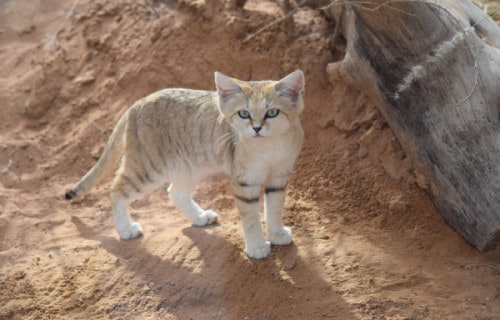
CCL: http://bit.ly/2zBWbKi
Arabian Sand Cat Facts
- Next in our article on 7 Lesser Known African Mammals comes the second of the two felines, the Arabian Sand Cat.
- Most notably, this fabulous mammal also remains quite popular as the sand dune cat. Furthermore, the mammal forms the only feline that resides principally within the true desert.
- In addition, this rather fascinating small feline species was first identified in 1858. This actually occurred as a result of one being seen in the Sahara, quite by accident.
- Also of importance, in 2002, the IUCN originally listed the mammal as Near Threatened on its list. This occurred due to concerns about potential low population size and decline.
- However, in 2016, after reviewing promising new data, that status was significantly upgraded to Least Concern.
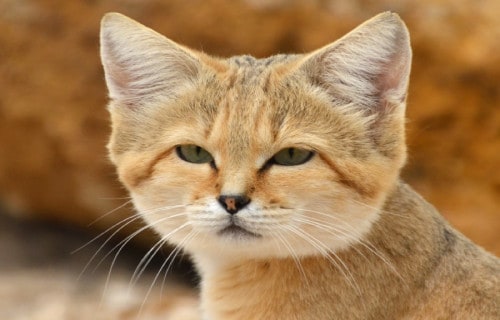
CCL: http://bit.ly/2zBWbKi
Arabian Sand Cat Physical Description
Firstly, the Arabian Sand Cat represents a small species of a wildcat. It also seems to be highly adapted to its environment. It possesses a stocky build, with short legs and a rather long tail.
Individuals generally show a light tan in color. Additionally, the fur most commonly appears without spots or stripes. The chin, lips, belly, and throat display white. The ears show tawny brown at the base with a black tip.
This cat also attains a normal body length of as much as 20 in (52 cm). The longer than average tail may also reach 12.2 in (1 cm) in length. Further, some individuals occasionally weigh up to 7.1 lb (3.2 kg).
The bottom of its paws becomes extremely thickly padded. This, as a result, naturally provides protection from the desert terrain. The ears grow large, compared to other small wildcats.
Acute hearing remains a survival necessity in an environment where prey stays scarce.
- Kingdom: Animalia
- Phylum: Chordata
- Class: Mammalia
- Order: Carnivora
- Family: Felidae
- Genus: Felis
- Species: F. margarita
Arabian Sand Cat Distribution, Habitat, and Ecology
The magnificent Arabian Sand Cat appears to have a widespread, though disjointed distribution. It mainly inhabits largely the deserts of northern Africa. But, it also appears to be present in smaller populations in central and southwest Asia.
In North Africa, the cat appears in numerous locations. These include Morocco, the Sinai Peninsula, Egypt, Libya, Chad, and Sudan. In Asia, it lives in an area ranging from the Caspian Sea to the northern border of Afghanistan.
This feline likes both sandy and stony desert regions. It also seems to prefer flat or undulating terrain with little vegetation. It also typically avoids bare sand dunes. In such locations, there is comparatively little food.
The feline remains capable of surviving in temperatures ranging from 23F-126F (-5C-52C). But, quite wisely, individuals will withdraw to burrows during extreme conditions.
While the feline will, of course, drink when water is available, it can survive for months just on the water in its food.
Bat-Eared Fox
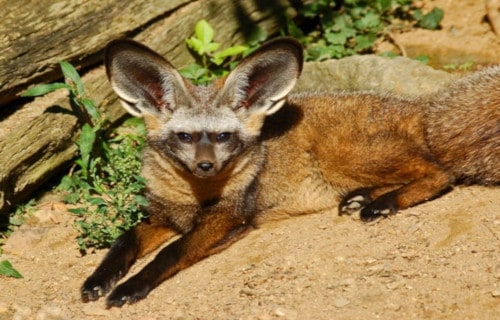
CCL: http://bit.ly/2IjEG4n
Bat-Eared Fox Facts
- The sixth of our choices for inclusion among these 7 Lesser Known African Mammals is the only canid, the Bat-Eared Fox.
- Most notably, the fascinating looking fox forms a very special species of wild canine. Further, the animal also evolved as endemic to a rather restricted range of the world.
- In addition, its distinctive name, quite understandably, derives from its unusually large ears. In fact, these rank among the largest in the entire animal kingdom, at least in relation to its body size.
- Unlike other canines, this unique animal will also occasionally form polygynous pairings when mating.
- Fortunately, the IUCN currently lists this remarkable animal as a Species of Least Concern. Thankfully, this ranking occurs due to sufficient numbers, despite its rather limited range.
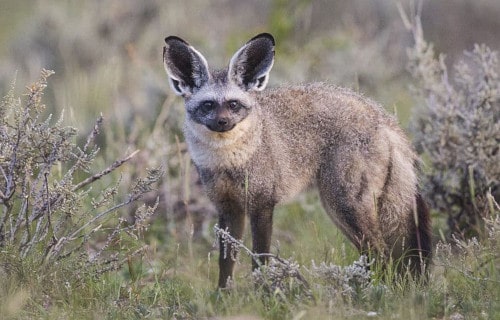
CCL: http://bit.ly/2IjEG4n
Bat-Eared Fox Physical Description
First of all, the fur of the fascinating Bat-Eared Fox has a decidedly eye-catching appeal. That’s because it predominantly appears brown and tawny in color, at least in the majority of individuals.
Also, the rather distinctive markings of this unique animal typically include black legs, ears, and portions of its face.
In addition, the head and body length of the fascinating canid average around 21.6 in (55 cm). In addition, its ears develop quite long. The pronounced ears usually have a length of about 5.1 in (13 cm).
Further, its body has also evolved the incredible ability to require very little fresh water. As a result, therefore, the majority of its water intake is provided by the bodily moisture of its prey.
- Kingdom: Animalia
- Phylum: Chordata
- Class: Mammalia
- Order: Carnivora
- Family: Canidae
- Genus: Otocyon
- Species: O. megalotis
Bat-Eared Fox Distribution, Habitat, and Ecology
The astonishing looking Bat-Eared Fox evolved as native to a rather broad range of the world. For the most part, this remains limited to the African savannas. There, its coloring provides excellent camouflage.
Sadly, however, currently, only two known population groups of Bat-Eared Fox still exist in Africa.
One of these is present in the southern regions including Angola, parts of Zambia, and South Africa. The other population group inhabits the region including Tanzania, Ethiopia, and also the southern portions of Sudan.
The canid also prefers to dwell in one of two types of habitat. One of these is the dry zones of the savanna, and another consists of short grasslands.
It also feeds principally as insectivorous in nature, and this is where the evolutionary trait of the over-sized ears comes into play. In its native environment, excellent hearing is a must for locating and catching its often highly elusive prey.
Yet, when necessary, individuals have also been seen to on upon a wide variety of invertebrates. These include beetles, crickets, ants, millipedes, grasshoppers, moths, scorpions, and spiders.
Naked Mole Rat
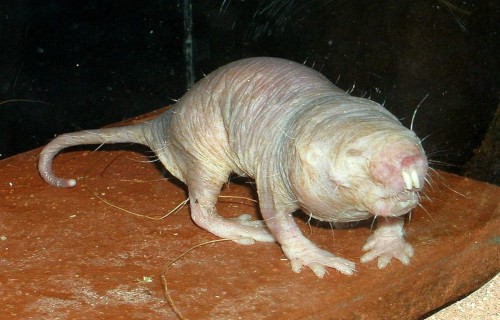
CCL: https://bit.ly/1p2b8Ke
Naked Mole Rat Facts
- Last, but absolutely not least, out of our selections for 7 Lesser Known African Mammals is the unbelievable Naked Mole Rat.
- Firstly, many people consider the fascinating small animal to be among the least visually appealing creatures on Earth. However, it nevertheless remains a remarkable animal.
- This is true due to, among other reasons, the fact that it has evolved an unprecedented characteristic. This amazing creature is completely incapable of feeling physical pain, unless its skin is breached.
- Further, it even deserves another nod for accomplishing the unusual. This admittedly odd looking animal remains one of only two known eusocial mammals in the entire world.
- Finally, the Naked Mole Rat is also surprising agile and nimble. This bizarre species has the uncanny ability to move either forward or backward in its burrow with equal speed.
Naked Mole Rat Physical Description
Most notably, the incredible Naked Mole Rat remains a rather small animal. Further, it shows no noticeable degree of sex-based physical differences, except in the case of the queens.
Firstly, individuals of both genders, with the exception of the queen, average about 4 in (10 cm) in length. Furthermore, each averages about about 1.2 oz (35 gr) in weight. The aforementioned queens are, of course, larger and weigh about 1.8 oz (50 gr), however.
Also, the legs grow thin and comparatively short, providing agility in its environment. In addition, the large, protruding teeth are used for digging, while the eyes remain small and the vision poor.
- Kingdom: Animalia
- Phylum: Chordata
- Class: Mammalia
- Order: Rodentia
- Family: Heterocephalidae
- Genus: Heterocephalus
- Species: H. glaber
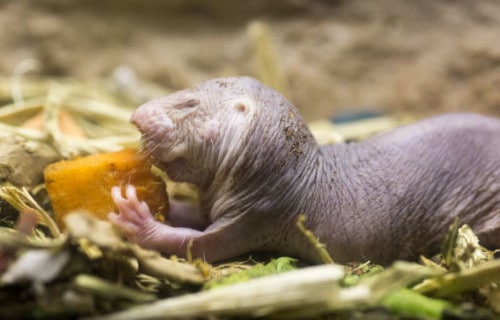
CCL: https://bit.ly/1iowB8m
Naked Mole Rat Distribution, Habitat, and Ecology
First of all, the remarkable Naked Mole Rat evolved as endemic to only the driest portions of one area. This area consists of tropical grasslands in East Africa, predominantly in Kenya, Ethiopia, and Somalia.
Furthermore, the animal typically feeds principally upon large tubers that it finds in its tunneling. In addition, a single large tuber may feed an entire colony for months, possibly even years.
This is because the species has developed the habit a unique strategy. Individuals eat the inside of the tuber, while leaving the outside intact, allowing it to continually regenerate.
It also lives in colonies, which average between 30-300 individuals, in underground burrows. The smaller workers primarily work within the tunnels of the colony, while the larger ones function principally as guards, protecting the colony from attackers.
The animal has further, perhaps to its detriment, become a centerpiece of scientific research in recent years. This occurs since it lives many times longer than any other rodent, and may show resistance to cancer.
7 Lesser Known African Mammals
We truly hope that you have enjoyed our article on 7 Lesser Known African Mammals. The wildlife in this part of the world astounds us with its beauty and variety. But many of the species that call the region home, be they mammals, plants, reptiles, birds, or insects, all need our help. The depredations man has inflicted on this world threaten all life, but some species more than others. It is up to us to do all that we can to protect and preserve them for our posterity.
Check out our other articles on 5 Fabulous Deer Varieties, 5 Spellbinding Scorpions, Breathtaking Asian Species, Incredible Sharks of the World
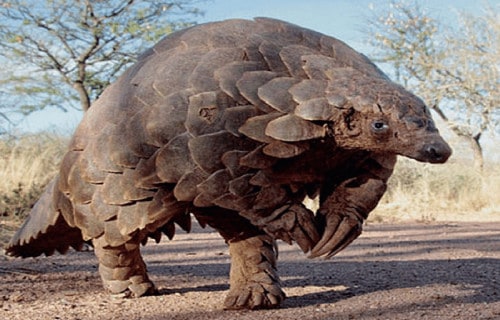
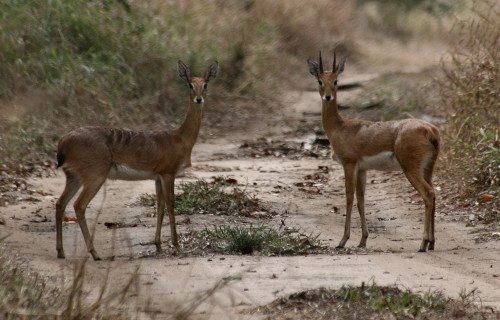
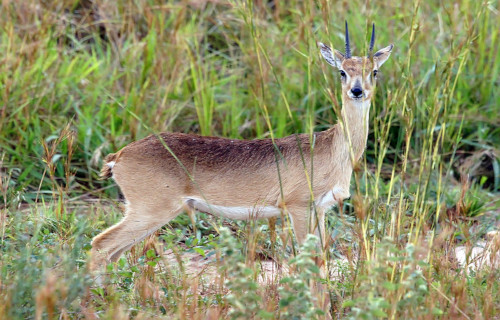
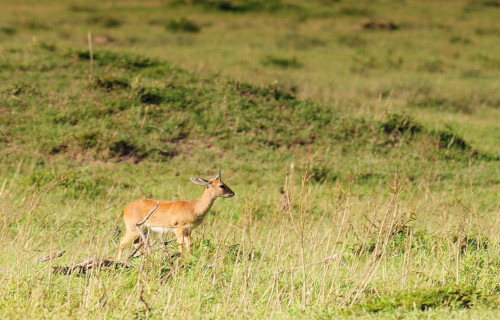
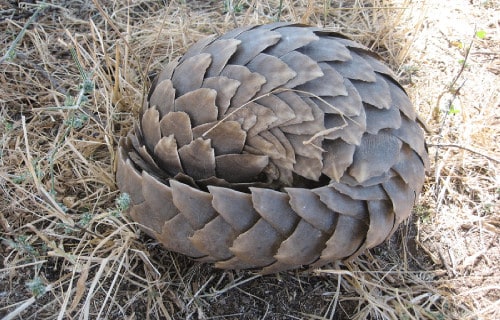
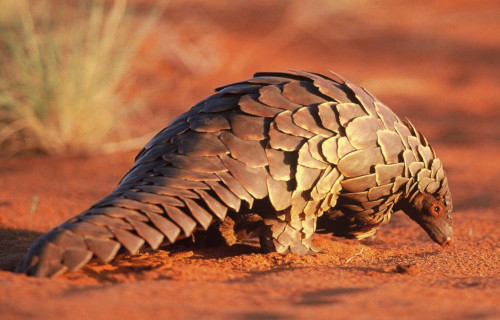
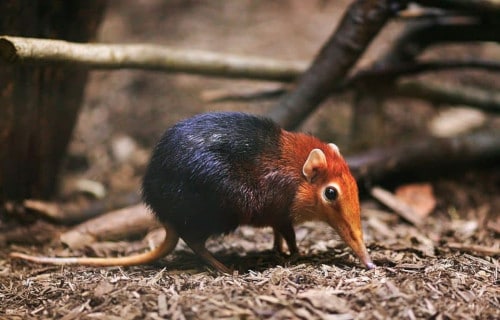
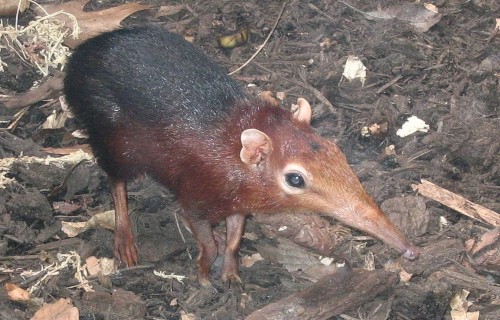
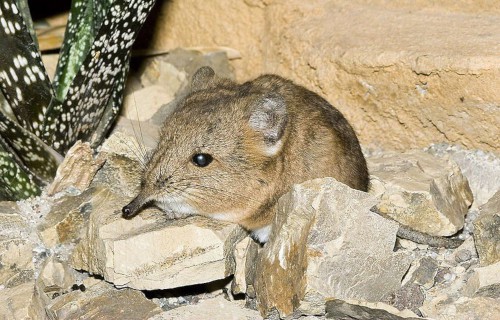
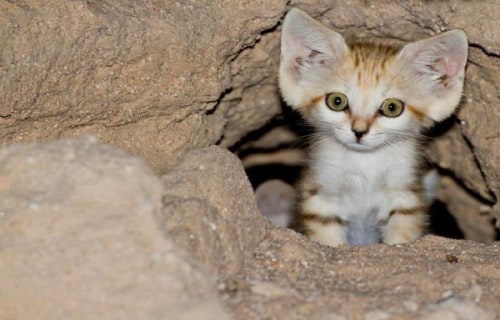
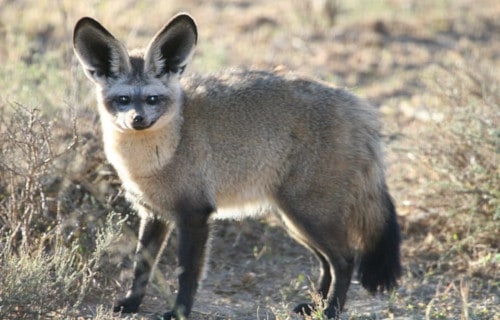
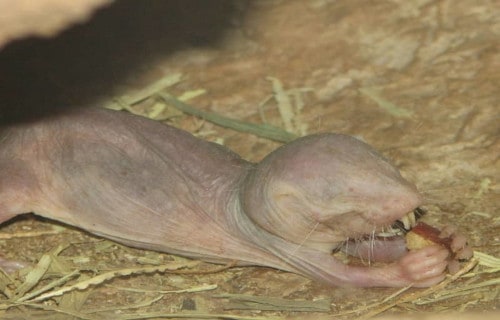









Leave a Reply